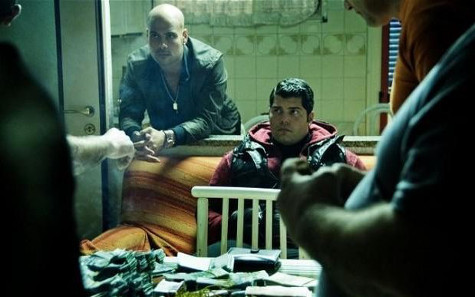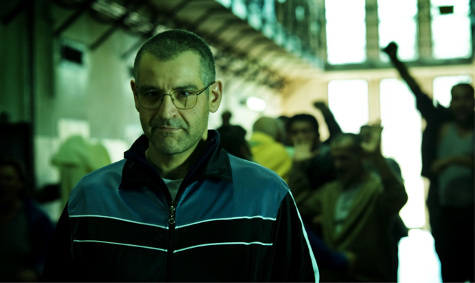
Naples is one of the oldest continuously-occupied cities in the world, but it’s mostly known for three things: pizza (most of the pizza we eat is Neapolitan-style), Mt. Vesuvius, and being perhaps the most spectacularly corrupt city in Italy. This last is quite an accomplishment, something like being the tallest man in the NBA. As you might expect for such a place, Naples has its very own mafia—the Camorra, which has been around for so long that no one knows exactly when it started.
Americans are used to the Sicilian mafia, which gained prominence during Prohibition and spawned slews of movies and TV series. They’ve mostly never heard of the Camorra. The Sundance Channel aims to fix this by importing the most popular series on current Italian TV: Gomorrah.
Gomorrah, the series, is based on the award-winning 2008 movie, which is in turn based on Roberto Saviano’s 2006 bestselling true-crime book. All three have somewhat different narratives, but all follow the camorristi in almost anthropological detail.
 The central character (there are no heroes) is Ciro di Marzio (Marco d’Amore, A Quiet Life), a stone killer who’s a key player in Don Pietro Savastano’s (Fortunato Cerlino, Hannibal) faction of the Camorra. Now in his mid-thirties, Ciro was orphaned young and brought up by Attilio, a seasoned camorrista and Ciro’s ticket into the gang. Ciro’s ability to get through combat uninjured has bought him the nickname “The Immortal.” His hot wife and cute six-year-old daughter bring out his domestic side.
The central character (there are no heroes) is Ciro di Marzio (Marco d’Amore, A Quiet Life), a stone killer who’s a key player in Don Pietro Savastano’s (Fortunato Cerlino, Hannibal) faction of the Camorra. Now in his mid-thirties, Ciro was orphaned young and brought up by Attilio, a seasoned camorrista and Ciro’s ticket into the gang. Ciro’s ability to get through combat uninjured has bought him the nickname “The Immortal.” His hot wife and cute six-year-old daughter bring out his domestic side.
When Don Pietro ends up in prison, his spoiled and none-too-bright son, Gennaro (Salvatore Esposito in his first major role), is supposed to take over the gang with Ciro’s backing. However, Don Pietro’s wife Immacolata (Maria Pia Calzone, lots of Italian film and TV), other members of the gang, and Ciro himself all have other ideas. While this drama is playing out at the top, rival gangs are chewing away at the Savastano turf, especially Salvatore Conte (Marco Palvetti, various Italian stage and screen productions), whose “mischief” at the beginning of the series set off the crisis in Savastano-land.
While this sounds like the setup for any number of mafia shows you’ve watched, this is a whole different beast. The Camorra run a very flat organization compared to the Sicilian mafia; there’s no Commission to keep the rival gangs away from each other’s throats.
Also, the camorristi are working-class hoods who make no pretense of joining straight society or becoming respectable, even when they happen to have gobs of money. Don’t expect to see any of these people in tuxes or evening clothes, throwing elegant soirees, or summering in Capri. They’re thugs. Their kids go into the family business when they’re barely able to tie their own shoes, and don’t go to Dartmouth like Michael Corleone or live in the suburbs like Tony Soprano. Even Don Pietro, an nth-generation capo, is in character and action only one step away from the street.
There’s a lot of violence. The plot’s propelled by the tit-for-tat intramural carnage that the competing gangs wreak on each other with weapons ranging from assault rifles to desktop devotional statues. There’s nothing glamorous here—it’s shot in jagged, tight framing, with a lot of confusion thrown in to make it feel real.
This action happens in the midst of the ragged, working-class-or-worse neighborhoods of Naples’ sprawl. The crumbling tower blocks and ruined factories look like the apocalypse has already come. Even Don Pietro’s ornate pink mansion is enclosed within one of the uglier concrete walls to feature on television lately and is overlooked by those crumbling tower blocks. The poverty and desperation of the gang’s turf is as pervasive as it was in the Baltimore ghetto that featured in The Wire, the American series that perhaps comes closest to Gomorrah’s ethos and feel.
All this plays out in the dark—literally. The characters’ apartments and houses are dimly lit at best, and the bulk of the action happens at night. Paolo Carnera’s camerawork is leached of almost all color, so the palette hardly strays from blacks and shades of gray, even in the rare daytime scenes.

In ways, this series feels almost like a documentary. Everyone speaks not merely Italian, but the local Neapolitan-Campania dialect, which sounds nothing like the language of amore; everything is subtitled, so don’t even think about running to the kitchen for more beer. We hear their music (often Italian rap or metal), see their (often atrocious) dress and interior decoration, and witness their customs and their behavior at home (so far, remarkably placid). Theirs is the sort of world in which ostentatious religiosity coexists with daily brutality and exploitation, where killers chide their cohorts for swearing in front of women while they discuss murder and mayhem. If it isn’t real, it sure feels like it. You might want a shower afterwards.
Gomorrah first aired on Sky Italia in 2014; a second season started in May 2016. The first season premiered on The Sundance Channel on August 24, 2016 and will run until mid-October. You can catch previous episodes on streaming video on the Sundance website.
Lance Charnes is an emergency manager and former Air Force intelligence officer. The characters in his international thriller Doha 12 and his upcoming art-crime novel The Collection pass through much nicer parts of Italy, while his near-future thriller South is set in Gomorrah’s level of grunge. His Facebook author page features spies, shipwrecks, art crime and archaeology, among other things.
